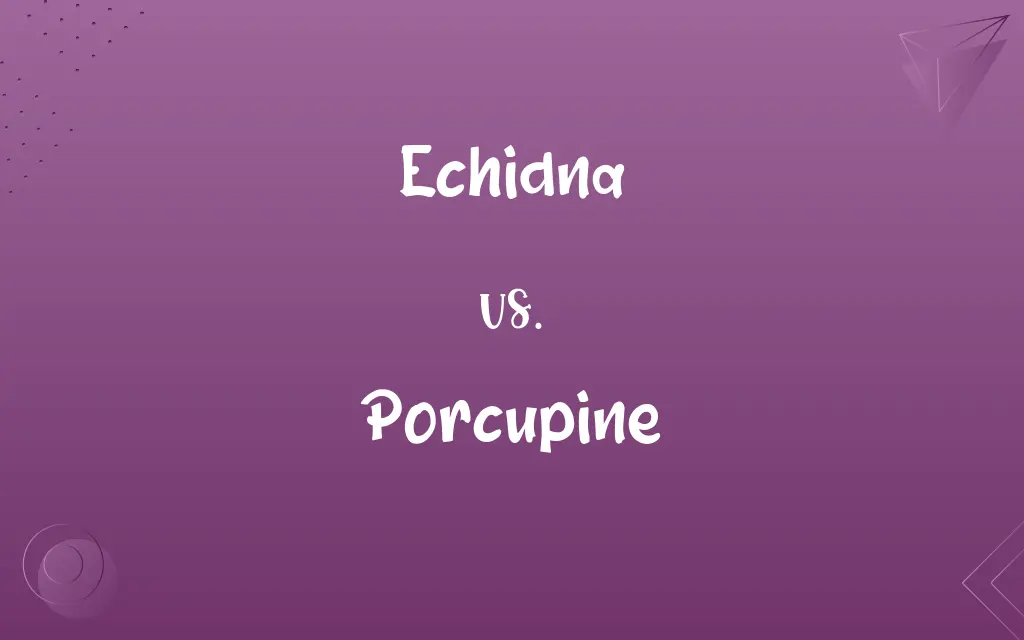Echidna vs. Porcupine: Know the Difference

By Shumaila Saeed || Updated on December 25, 2023
Echidnas are egg-laying mammals with spines and beak-like snouts, while porcupines are rodents with sharp quills for defense.

Key Differences
Echidnas, belonging to the monotreme family, are native to Australia and New Guinea, living in a variety of habitats. Porcupines are rodents found in the Americas, Europe, and Asia, adapting to forests, deserts, and mountains.
Shumaila Saeed
Nov 24, 2023
Echidnas have a distinctive appearance with spiny coats, short legs, and elongated, beak-like snouts. Porcupines are known for their sharp quills, which are modified hairs, and they have larger, robust bodies compared to echidnas.
Shumaila Saeed
Nov 24, 2023
Echidnas lay eggs, a rare trait among mammals, and they have a relatively long lifespan. Porcupines give birth to live young and have varying lifespans depending on the species.
Shumaila Saeed
Nov 24, 2023
Echidnas primarily feed on ants and termites, using their sticky, long tongues to capture prey. Porcupines have a plant-based diet, eating leaves, bark, and sometimes small twigs or fruits.
Shumaila Saeed
Nov 24, 2023
Echidnas use their spines as a defense mechanism, curling into a ball when threatened. Porcupines are famous for their quills, which can detach and embed in predators as a defense strategy.
Shumaila Saeed
Nov 24, 2023
ADVERTISEMENT
Comparison Chart
Word Origin
Derived from Greek, referring to a "viper" due to its appearance.
Comes from Middle French, meaning "thorn pig" due to its quilled back.
Shumaila Saeed
Nov 24, 2023
Part of Speech
Noun, used in zoology to describe a specific mammal.
Noun, used in zoology to refer to a specific rodent species.
Shumaila Saeed
Nov 24, 2023
Usage in Sentences
Often conveys exotic or unique wildlife.
Implies a well-known, quill-bearing rodent.
Shumaila Saeed
Nov 24, 2023
Collocations
Commonly associated with terms like 'monotreme', 'spiny', 'Australian'.
Often paired with words like 'quills', 'rodent', 'forest'.
Shumaila Saeed
Nov 24, 2023
ADVERTISEMENT
Echidna and Porcupine Definitions
Echidna
Echidnas are known for their egg-laying mammalian nature.
She was fascinated to learn that echidnas, like platypuses, lay eggs.
Shumaila Saeed
Nov 13, 2023
Porcupine
Porcupines use their quills as a defense mechanism against predators.
The predator yelped in pain after getting too close to the porcupine's quills.
Shumaila Saeed
Nov 13, 2023
Echidna
Echidnas have elongated snouts and no teeth.
The echidna's snout sniffed out insects hidden under rocks.
Shumaila Saeed
Nov 13, 2023
Porcupine
Porcupines are found in various habitats, from forests to deserts.
In the dense forest, the porcupine found plenty of food and shelter.
Shumaila Saeed
Nov 13, 2023
Echidna
An echidna is a spiny monotreme native to Australia and New Guinea.
The echidna burrowed into the ground to escape the heat.
Shumaila Saeed
Nov 13, 2023
ADVERTISEMENT
Porcupine
Porcupines are primarily nocturnal and have a herbivorous diet.
At night, the porcupine ventured out to nibble on bark and leaves.
Shumaila Saeed
Nov 13, 2023
Echidna
Echidnas have a diet mainly consisting of ants and termites.
The echidna used its long tongue to feast on a termite mound.
Shumaila Saeed
Nov 13, 2023
Porcupine
A porcupine is a large rodent known for its coat of sharp quills.
The porcupine raised its quills as a warning to the approaching fox.
Shumaila Saeed
Nov 13, 2023
Echidna
Echidnas possess a coat of spines for protection.
The echidna curled into a ball, its spines deterring the predator.
Shumaila Saeed
Nov 13, 2023
Porcupine
Any of various rodents of the family Hystricidae, of Eurasia and Africa, or the family Erethizontidae, of the Americas, having long, sharp, erectile quills.
Shumaila Saeed
Oct 19, 2023
Echidna
Any of several nocturnal burrowing egg-laying mammals of the genera Tachyglossus and Zaglossus of Australia, Tasmania, and New Guinea, having a spiny coat, a slender snout, and an extensible sticky tongue used for catching insects.Also called spiny anteater.
Shumaila Saeed
Oct 19, 2023
Porcupine
Any of several rodents of either of the taxonomic families Hystricidae (Old World porcupines) or Erethizontidae (New World porcupines), both from the infraorder Hystricognathi, noted for their sharp spines or quills, which are raised when the animal is attacked or surprised.
Shumaila Saeed
Oct 19, 2023
Echidna
Any of the species of small spined monotremes in family Tachyglossidae, the four extant species of which are found in Australia and southern New Guinea.
Shumaila Saeed
Oct 19, 2023
Porcupine
Any Old Word rodent of the genus Hystrix, having the back covered with long, sharp, erectile spines or quills, sometimes a foot long. The common species of Europe and Asia (Hystrix cristata) is the best known.
Shumaila Saeed
Oct 19, 2023
Porcupine
Any species of Erethizon and related genera, native of America. They are related to the true porcupines, but have shorter spines, and are arboreal in their habits. The Canada porcupine (Erethizon dorsatus) is a well known species.
Shumaila Saeed
Oct 19, 2023
Echidna
A genus of Monotremata found in Australia, Tasmania, and New Guinea. They are toothless and covered with spines; - called also porcupine ant-eater, and Australian ant-eater.
Shumaila Saeed
Oct 19, 2023
Porcupine
Relatively large rodents with sharp erectile bristles mingled with the fur
Shumaila Saeed
Oct 19, 2023
Echidna
Burrowing spine-covered monotreme of Australia having a long snout and claws for hunting ants and termites
Shumaila Saeed
Oct 19, 2023
Repeatedly Asked Queries
What is a porcupine?
A porcupine is a large rodent known for its coat of sharp spines or quills.
Shumaila Saeed
Nov 24, 2023
Are echidnas solitary animals?
Yes, echidnas are generally solitary except during mating season.
Shumaila Saeed
Nov 24, 2023
What do echidnas eat?
Echidnas primarily eat ants and termites, using their long, sticky tongue to capture them.
Shumaila Saeed
Nov 24, 2023
Are echidnas endangered?
Echidnas are not currently endangered, but their habitat is under threat from human activities.
Shumaila Saeed
Nov 24, 2023
Are porcupines found in Australia?
No, porcupines are not native to Australia; they are found in the Americas, Europe, and Asia.
Shumaila Saeed
Nov 24, 2023
Do echidnas have quills like porcupines?
Echidnas have spines, which are similar to quills but are shorter and mixed with fur.
Shumaila Saeed
Nov 24, 2023
Can echidnas climb trees?
Some species of echidnas, like the short-beaked echidna, are capable of climbing.
Shumaila Saeed
Nov 24, 2023
What is an echidna?
An echidna is a small, egg-laying mammal native to Australia and New Guinea, known for its spines.
Shumaila Saeed
Nov 24, 2023
Do porcupines shoot their quills?
No, porcupines cannot shoot their quills, but the quills can detach easily when touched.
Shumaila Saeed
Nov 24, 2023
What is the size of a porcupine?
Porcupines can vary in size but typically range from 60 to 90 cm (2 to 3 feet) in length.
Shumaila Saeed
Nov 24, 2023
How do porcupines protect themselves?
Porcupines protect themselves by raising their quills to appear larger and deter predators.
Shumaila Saeed
Nov 24, 2023
What is the habitat of a porcupine?
Porcupines inhabit a variety of environments, including forests, deserts, and grasslands.
Shumaila Saeed
Nov 24, 2023
Do echidnas lay eggs?
Yes, echidnas are one of the few mammals (monotremes) that lay eggs.
Shumaila Saeed
Nov 24, 2023
What are the main predators of porcupines?
Major predators of porcupines include large carnivores like mountain lions, wolves, and large birds of prey.
Shumaila Saeed
Nov 24, 2023
How do porcupines mate without injuring each other?
Porcupines have a careful mating process where the female's quills lie flat, reducing the risk of injury.
Shumaila Saeed
Nov 24, 2023
What type of climate do echidnas prefer?
Echidnas can adapt to various climates, from arid deserts to snowy highlands.
Shumaila Saeed
Nov 24, 2023
Are porcupines active during the day or night?
Most porcupines are nocturnal, meaning they are active during the night.
Shumaila Saeed
Nov 24, 2023
How long do echidnas live?
Echidnas can live for up to 50 years in the wild.
Shumaila Saeed
Nov 24, 2023
Can porcupines swim?
Yes, some species of porcupines are good swimmers, with North American porcupines being particularly adept.
Shumaila Saeed
Nov 24, 2023
Can echidnas climb?
Some echidna species, like the short-beaked echidna, can climb trees and logs.
Shumaila Saeed
Nov 24, 2023
Share this page
Link for your blog / website
HTML
Link to share via messenger
About Author
Written by
Shumaila SaeedShumaila Saeed, an expert content creator with 6 years of experience, specializes in distilling complex topics into easily digestible comparisons, shining a light on the nuances that both inform and educate readers with clarity and accuracy.






































































